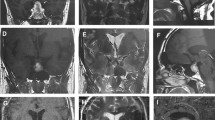Summary
Authors analised retrospectively the incidence of pituitary apoplexy in a series of 799 pituitary adenomas with respect to the long term follow-up of the patients.
Focal vascular abnormalities in histological specimens of tumours, regarded as morphological suggestion of past apoplexy (heamorrhage, ischaemic infarction or necrosis), were established in 113 out of 783 surgical cases (14.4%).
Acute clinical onset, justifying the clinical diagnosis of pituitary apoplexy, occurred in 39 patients only (5% of the whole series), 19 of them were subjected to urgent surgical decompression due to severe neurological deficit. The haemorrhagic character of apoplexy was established in most cases requiring immediate surgery.
The detailed clinical picture of this condition and its management are discussed with respect to the long term prognosis.
On this basis the authors suggest the necessity of surgical treatment in every case of pituitary apoplexy, taking into account not only neurological recovery, but also endocrine and oncological aspects of the disease. The observation that pituitary apoplexy may be a “marker” of tumour invasiveness (even in small, “enclosed” adenomas) is highlighted.
Similar content being viewed by others
References
Arafah BM, Harrington JF, Madhoun ZT,et al (1990) Improvement of pituitary function after surgical decompression for pituitary tumour apoplexy. J Clin Endocrinol Metab 71: 323–328
Bernstein M, Hegete R, Gentili F (1984) Pituitary apoplexy associated with a triple bolus test. J Neurosurg 61: 586
Byerre P, Lindholm J, Viderae KH (1986) The spontaneous course of pituitary adenomas and occurence of an empty sella in untreated acromegaly. J Clin Endocrinol Metab 63: 287–291
Cardoso ER, Peterson EW (1984) Pituitary apoplexy. A review. Neurosurgery 14: 363–373
Chapman A, Williams G, Hockley A,et al (1985) Pituitary apoplexy after combined test of anterior pituitary function. Brit Med J 291: 26–29
Ebersold MJ, Laws ER, Scheithauer BW,et al (1983) Pituitary apoplexy treated by transsphenoidal surgery. J Neurosurg 58: 315–320
Gorczyca W, Hardy J (1988) Microadenomas of the human pituitary and their vascularisation. Neurosurgery 22: 1–6
Hodgkinson S, Allolio B, Landon J,et al (1984) Development of a non-extracted two-site immuno-radiometric assay for corticotropin utilizing amino —a and carboxy-terminally directed antibodies. Biochemistry J 218: 703–706
Jordan RM, Cook DM, Kendall JW,et al (1979) Nelson's syndrome and spontaneous pituitary tumour infarction. Arch Intern Med 139: 340–342
Kasperlik-Zaiuska AA, Nielubowicz J, Wisławski J,et al (1983) Nelson's syndrome: incidence and prognosis. Clin Endocrinol 19: 693–698
Landolt AM (1980) Biology of pituitary microadenomas. In: Faglia G, Gionvanelli MA, MacLeod RM (eds) Pituitary microadenomas. Academic Press, London, pp 107–122
Laws ER Jr, Ebersold MJ (1983) Pituitary apoplexy—an endocrine emergency. World J Surg 6: 686–688
Montalban J, Sumalla J, Fernandez JL (1988) Empty sella syndrome and pituitary apoplexy. Lancet 1: 774
Pozzati E, Frank G, Nasi MT, Giulani G (1987) Pituitary apoplexy, bilateral carotid vasospasm and cerebral infarction in a 15-year-old boy. Neurosurgery 20 (1): 56–59
Rouit RL, Fein JM (1972) Pituitary apoplexy: a review and reappraisal. J Neurosurg 37: 280–288
Shirataki K, Chihara K, Shibata Y,et al (1988) Pituitary apoplexy manifested during a bromocriptine test in patient with a growth hormone —and prolactin —producing pituitary adenoma. Neurosurgery 23: 395–397
Symon L, Mohanty S (1982) Haemorrhage in pituitary tumours. Acta Neurochir (Wien) 65: 41–49
Taylor AL, Finster JL, Raskin P,et al (1968) Pituitary apoplexy in acromegaly. J Clin Endocrinol Metab 28: 1784–1792
Wakai S, Fukushima T, Teramoto A,et al (1981) Pituitary apoplexy: its incidence and clinical significance. J Neurosurg 55: 187–193
Wisiawski J, Kasperlik-Załuska AA, Jeske W,et al (1985) Results of neurosurgical treatment by a transsphenoidal approach in 10 patients with Nelson's syndrome. J Neurosurg 62: 68–71
Author information
Authors and Affiliations
Rights and permissions
About this article
Cite this article
Bonicki, W., Kasperlik-Załuska, A., Koszewski, W. et al. Pituitary apoplexy: Endocrine, surgical and oncological emergency. Incidence, clinical course and treatment with reference to 799 cases of pituitary adenomas. Acta neurochir 120, 118–122 (1993). https://doi.org/10.1007/BF02112028
Issue Date:
DOI: https://doi.org/10.1007/BF02112028




